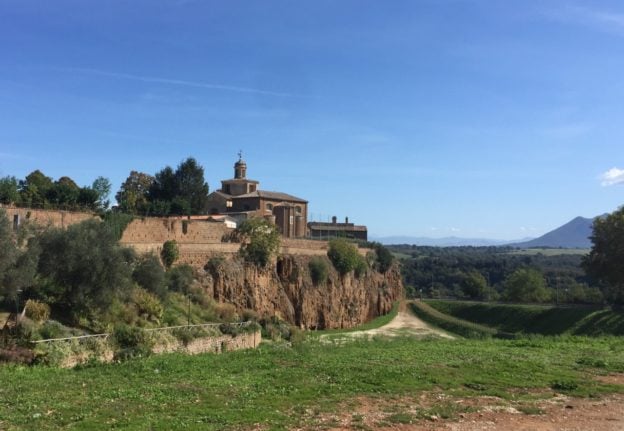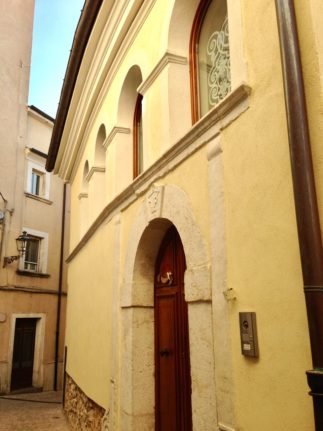PROPERTY: Why buyers need to watch out for Italy's conservation rules

Old Italian homes featuring frescoes, loggias or ancient cellars are appealing, but such buildings are often protected by Italy’s cultural heritage authority - meaning lots of red tape for owners, as Silvia Marchetti explains.
Italy is dotted with gorgeous hilltop villages full of centuries-old homes for sale complete with characteristic features. But many people don’t realise that these buildings, even if they’re abandoned or decaying, often fall under restrictions (vincoli) enforced by Italy’s ‘art authorities’, known as the sovraintendenza belle arti.
Due to the artistic and historic value of these buildings, they’re considered a part of the national heritage. This is usually because they date back to medieval and Renaissance times, or because they feature frescoed walls, emblazoned vaults or entrance portals with coats of arms.
READ ALSO: How to avoid hidden traps when buying an old property in Italy
Italy has the most UNESCO-listed cities in the world, and here these vincoli are even more binding. Many buildings in Rome have entrance portals sculpted by Renaissance masters which are ‘off-limits’ even if they’re in need of repair.
It is a widespread way of protecting Italy’s heritage, and yet awareness of the risks buyers face if their property happens to be ‘supervised’ are often hidden, and are especially unknown to foreigners.
In almost every old rural village there are private houses and palazzos with ancient loggias, decorated ceilings and lavish stone columns, and even simple former farmers’ dwellings with ancient cellars, over which the art authorities have the final say on renovation work, even small upgrades like adding an extra room or pulling down a wall.
READ ALSO: Charming or boring – What do Italians think of life in the old town?
Giovanna Rosetta Fraire was forced to give up her dream of buying a portion of a two-floor 1700s building in the village of Civita Castellana, in Lazio, because it needed upgrades but the frescoed walls, ceilings, decorated fireplaces and elegant entrance were ‘vincolati’ (under restrictions).
“It was a historic building with an artistic value. The peeling façade needed a makeover but it was still the original color dating back centuries so we couldn’t paint over it,” she explains.
“The rusty wrought-iron balconies were made in the 18th century while the location was in the heart of the historical center, right in front of the Gothic cathedral, so any change to the building would have affected the scenery, too.”
Fraire only found out about these rules by chance, just before signing the purchase deed, thanks to a tip from a local resident.
According to Italian law, fixes to similar buildings of value need to be coordinated and approved by the sovrintendenza, which seldom allows any changes to the exterior and only minimal ones inside crumbled rooms, for instance those struck by an earthquake.
Usually the structure of a ‘vincolata’ building cannot be modified at all: walls cannot be pulled down, nor a room expanded or divided in two.
And when old homes are embedded within the fortified medieval walls or share a wall with a castle or fortress it is even more complicated.

Civita Castellana. Photo: Silvia Marchetti
Cesidio Diciacca bought a former abbot’s lodgings dating from the 1700s, embedded within the rampart in the village of Picinisco, north of Naples,
He contacted the local belle arti before restyling it to find out whether there were any restrictions, which is always the best thing to do. Unearthing an updated map of your property from the catasto (land registry) is also useful.
“The belle arti stopped all external changes as we are in the centro storico,” he says. “The only external fix allowed was to remove the top level of the guard tower which was ugly and out of place, and we had issues also placing solar panels.
“The whole of the centro storico of Picinisco and neighboring hill towns are protected in some way which is both good and bad as it prevents necessary work of modernisation.”
It should be a matter of striking the right balance between preservation and valorization of old properties, but this is rarely the case in Italy when art authorities are involved.

Cesidio Diciacca’s house in Picinisco. Photo: Silvia Marchetti
Giovanna Rossi owns a tiny dwelling in the picturesque Tuscan village of Pitigliano, where old homes are cropped on a high plateau and carved from the tuff rock.
Like most other villages in the area, Pitigliano has Etruscan roots and many dwellings come with pagan caves considered by authorities to be monuments of anthropological interest, a bit like Matera’s.
“I have this stunning underground canteen accessible from my kitchen but cannot change it in any way to make it habitable, it’s a pity. I just show it to friends and keep wine bottles in it,” she says.
Even private gardens and patches of land, set within or close to ’archaic’ protected parks where Etruscan or Ancient Roman tombs and ruins have been unearthed, have archaeological vincoli and cannot be modified without the necessary green lights.
These are ‘vincolati’ by authorities unless there are specific geological permits which allow the construction of a swimming pool, a gazebo or tiny cottage, following land surveys proving the spot is clear of historic finds.
That’s without mentioning that when a Roman sarcophagus or column pops out buried in your backyard, you must tell the belle arti at once or face fines, and potential seizure.
Other European countries have similar rules, like Historic England's listed buildings, but these seem to create restrictions to a lesser degree compared to Italy’s huge and sometimes cumbersome heritage.
Comments
See Also
Italy is dotted with gorgeous hilltop villages full of centuries-old homes for sale complete with characteristic features. But many people don’t realise that these buildings, even if they’re abandoned or decaying, often fall under restrictions (vincoli) enforced by Italy’s ‘art authorities’, known as the sovraintendenza belle arti.
Due to the artistic and historic value of these buildings, they’re considered a part of the national heritage. This is usually because they date back to medieval and Renaissance times, or because they feature frescoed walls, emblazoned vaults or entrance portals with coats of arms.
READ ALSO: How to avoid hidden traps when buying an old property in Italy
Italy has the most UNESCO-listed cities in the world, and here these vincoli are even more binding. Many buildings in Rome have entrance portals sculpted by Renaissance masters which are ‘off-limits’ even if they’re in need of repair.
It is a widespread way of protecting Italy’s heritage, and yet awareness of the risks buyers face if their property happens to be ‘supervised’ are often hidden, and are especially unknown to foreigners.
In almost every old rural village there are private houses and palazzos with ancient loggias, decorated ceilings and lavish stone columns, and even simple former farmers’ dwellings with ancient cellars, over which the art authorities have the final say on renovation work, even small upgrades like adding an extra room or pulling down a wall.
READ ALSO: Charming or boring – What do Italians think of life in the old town?
Giovanna Rosetta Fraire was forced to give up her dream of buying a portion of a two-floor 1700s building in the village of Civita Castellana, in Lazio, because it needed upgrades but the frescoed walls, ceilings, decorated fireplaces and elegant entrance were ‘vincolati’ (under restrictions).
“It was a historic building with an artistic value. The peeling façade needed a makeover but it was still the original color dating back centuries so we couldn’t paint over it,” she explains.
“The rusty wrought-iron balconies were made in the 18th century while the location was in the heart of the historical center, right in front of the Gothic cathedral, so any change to the building would have affected the scenery, too.”
Fraire only found out about these rules by chance, just before signing the purchase deed, thanks to a tip from a local resident.
According to Italian law, fixes to similar buildings of value need to be coordinated and approved by the sovrintendenza, which seldom allows any changes to the exterior and only minimal ones inside crumbled rooms, for instance those struck by an earthquake.
Usually the structure of a ‘vincolata’ building cannot be modified at all: walls cannot be pulled down, nor a room expanded or divided in two.
And when old homes are embedded within the fortified medieval walls or share a wall with a castle or fortress it is even more complicated.

Cesidio Diciacca bought a former abbot’s lodgings dating from the 1700s, embedded within the rampart in the village of Picinisco, north of Naples,
He contacted the local belle arti before restyling it to find out whether there were any restrictions, which is always the best thing to do. Unearthing an updated map of your property from the catasto (land registry) is also useful.
“The belle arti stopped all external changes as we are in the centro storico,” he says. “The only external fix allowed was to remove the top level of the guard tower which was ugly and out of place, and we had issues also placing solar panels.
“The whole of the centro storico of Picinisco and neighboring hill towns are protected in some way which is both good and bad as it prevents necessary work of modernisation.”
It should be a matter of striking the right balance between preservation and valorization of old properties, but this is rarely the case in Italy when art authorities are involved.

Giovanna Rossi owns a tiny dwelling in the picturesque Tuscan village of Pitigliano, where old homes are cropped on a high plateau and carved from the tuff rock.
Like most other villages in the area, Pitigliano has Etruscan roots and many dwellings come with pagan caves considered by authorities to be monuments of anthropological interest, a bit like Matera’s.
“I have this stunning underground canteen accessible from my kitchen but cannot change it in any way to make it habitable, it’s a pity. I just show it to friends and keep wine bottles in it,” she says.
Even private gardens and patches of land, set within or close to ’archaic’ protected parks where Etruscan or Ancient Roman tombs and ruins have been unearthed, have archaeological vincoli and cannot be modified without the necessary green lights.
These are ‘vincolati’ by authorities unless there are specific geological permits which allow the construction of a swimming pool, a gazebo or tiny cottage, following land surveys proving the spot is clear of historic finds.
That’s without mentioning that when a Roman sarcophagus or column pops out buried in your backyard, you must tell the belle arti at once or face fines, and potential seizure.
Other European countries have similar rules, like Historic England's listed buildings, but these seem to create restrictions to a lesser degree compared to Italy’s huge and sometimes cumbersome heritage.
Join the conversation in our comments section below. Share your own views and experience and if you have a question or suggestion for our journalists then email us at [email protected].
Please keep comments civil, constructive and on topic – and make sure to read our terms of use before getting involved.
Please log in here to leave a comment.